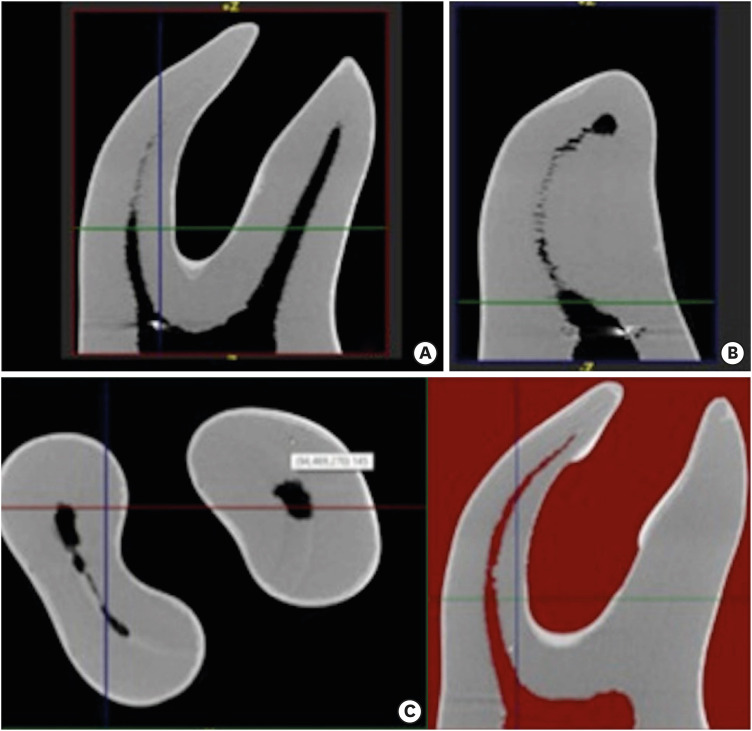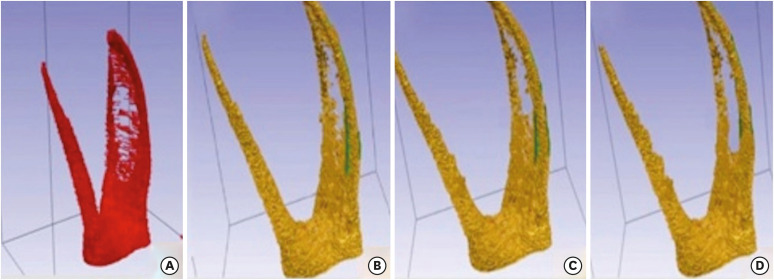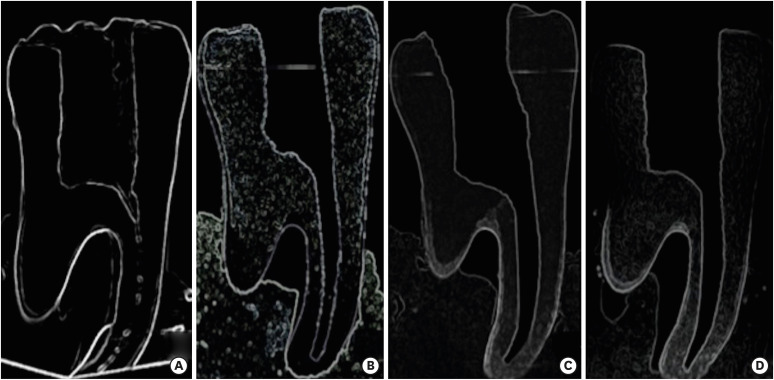1. Peters OA, Schönenberger K, Laib A. Effects of four Ni-Ti preparation techniques on root canal geometry assessed by micro computed tomography. Int Endod J. 2001; 34:221–230. PMID:
12193268.

2. Schilder H. Cleaning and shaping the root canal. Dent Clin North Am. 1974; 18:269–296. PMID:
4522570.
3. Mittal A, Dadu S, Singh NS, Singh S, Gupta B, Abraham A, Yendrembam B, Kumari S. Comparative assessment of canal transportation and centering ability of Reciproc and One Shape File systems using CBCT-an in vitro study. J Clin Diagn Res. 2017; 11:ZC31–ZC34.
4. Schäfer E, Tepel J, Hoppe W. Properties of endodontic hand instruments used in rotary motion. Part 2. Instrumentation of curved canals. J Endod. 1995; 21:493–497. PMID:
8596068.

5. Celikten B, Uzuntas CF, Kursun S, Orhan AI, Tufenkci P, Orhan K, Demiralp KÖ. Comparative evaluation of shaping ability of two nickel-titanium rotary systems using cone beam computed tomography. BMC Oral Health. 2015; 15:32. PMID:
25887521.

6. Thompson SA, Dummer PM. Shaping ability of lightspeed rotary nickel-titanium instruments in simulated root canals. Part 1. J Endod. 1997; 23:698–702. PMID:
9587312.

7. Bergmans L, Van Cleynenbreugel J, Wevers M, Lambrechts P. Mechanical root canal preparation with NiTi rotary instruments: rationale, performance and safety. Status report for the American Journal of Dentistry. Am J Dent. 2001; 14:324–333. PMID:
11803999.
8. Duque JA, Vivan RR, Cavenago BC, Amoroso-Silva PA, Bernardes RA, Vasconcelos BC, Duarte MA. Influence of NiTi alloy on the root canal shaping capabilities of the ProTaper Universal and ProTaper Gold rotary instrument systems. J Appl Oral Sci. 2017; 25:27–33. PMID:
28198973.

9. Alapati SB, Brantley WA, Iijima M, Clark WA, Kovarik L, Buie C, Liu J, Ben Johnson W. Metallurgical characterization of a new nickel-titanium wire for rotary endodontic instruments. J Endod. 2009; 35:1589–1593. PMID:
19840654.

10. Zhou H, Peng B, Zheng YF. An overview of the mechanical properties of nickel titanium endodontic instruments. Endod Topics. 2013; 29:42–54.
12. Peters OA, Arias A, Paqué F. A micro-computed tomographic assessment of root canal preparation with a novel instrument, TRUShape, in mesial roots of mandibular molars. J Endod. 2015; 41:1545–1550. PMID:
26238528.

13. Micro Mega. MM.Tooth, as Real as a Natural Tooth, the Ideal Training Material [Internet]. Besancon: Micro Mega;c2018. cited 2018 Jul 30. updated 2018 Jul 30. Available from:
https://micro-mega.com/mm-tooth?lang=en.
14. Feldkamp LA, Goldstein SA, Parfitt AM, Jesion G, Kleerekoper M. The direct examination of three-dimensional bone architecture
in vitro by computed tomography. J Bone Miner Res. 1989; 4:3–11. PMID:
2718776.
15. Gambill JM, Alder M, del Rio CE. Comparison of nickel-titanium and stainless steel hand-file instrumentation using computed tomography. J Endod. 1996; 22:369–375. PMID:
8935064.

16. Keskin C, Demiral M, Sarıyılmaz E. Comparison of the shaping ability of novel thermally treated reciprocating instruments. Restor Dent Endod. 2018; 43:e15. PMID:
29765896.

17. Bergmans L, Van Cleynenbreugel J, Beullens M, Wevers M, Van Meerbeek B, Lambrechts P. Progressive versus constant tapered shaft design using NiTi rotary instruments. Int Endod J. 2003; 36:288–295. PMID:
12702124.

18. Bergmans L, Van Cleynenbreugel J, Wevers M, Lambrechts P. A methodology for quantitative evaluation of root canal instrumentation using microcomputed tomography. Int Endod J. 2001; 34:390–398. PMID:
11482723.

19. Peters OA, Laib A, Göhring TN, Barbakow F. Changes in root canal geometry after preparation assessed by high-resolution computed tomography. J Endod. 2001; 27:1–6. PMID:
11487156.

20. Versiani MA, Pécora JD, Sousa-Neto MD. The anatomy of two-rooted mandibular canines determined using micro-computed tomography. Int Endod J. 2011; 44:682–687. PMID:
21447139.

21. Versiani MA, Leoni GB, Steier L, De-Deus G, Tassani S, Pécora JD, de Sousa-Neto MD. Micro-computed tomography study of oval-shaped canals prepared with the self-adjusting file, Reciproc, WaveOne, and ProTaper Universal systems. J Endod. 2013; 39:1060–1066. PMID:
23880278.

22. Zhao D, Shen Y, Peng B, Haapasalo M. Root canal preparation of mandibular molars with 3 nickel-titanium rotary instruments: a micro-computed tomographic study. J Endod. 2014; 40:1860–1864. PMID:
25205262.
23. Stern S, Patel S, Foschi F, Sherriff M, Mannocci F. Changes in centring and shaping ability using three nickel–titanium instrumentation techniques analysed by micro-computed tomography (μCT). Int Endod J. 2012; 45:514–523. PMID:
22625863.

24. Ertuğrul İF. Effect of sodium hypochlorite on the cyclic fatigue resistance: a scanning electron microscopy evaluation. Microsc Res Tech. 2019; 82:2089–2094. PMID:
31574200.

25. Arias A, Singh R, Peters OA. Torque and force induced by ProTaper Universal and ProTaper Next during shaping of large and small root canals in extracted teeth. J Endod. 2014; 40:973–976. PMID:
24935546.

26. Ruddle CJ, Machtou P, West JD. The shaping movement: fifth-generation technology. Dent Today. 2013; 32:9496–99.
27. Capar ID, Ertas H, Ok E, Arslan H, Ertas ET. Comparative study of different novel nickel-titanium rotary systems for root canal preparation in severely curved root canals. J Endod. 2014; 40:852–856. PMID:
24862716.

28. Bürklein S, Poschmann T, Schäfer E. Shaping ability of different nickel-titanium systems in simulated S-shaped canals with and without glide path. J Endod. 2014; 40:1231–1234. PMID:
25069939.

29. Wu MK, Fan B, Wesselink PR. Leakage along apical root fillings in curved root canals. Part I: effects of apical transportation on seal of root fillings. J Endod. 2000; 26:210–216. PMID:
11199720.

30. Uzunoglu E, Turker SA. Comparison of canal transportation, centering ratio by cone-beam computed tomography after preparation with different file systems. J Contemp Dent Pract. 2015; 16:360–365. PMID:
26162254.
31. Hieawy A, Haapasalo M, Zhou H, Wang ZJ, Shen Y. Phase transformation behavior and resistance to bending and cyclic fatigue of ProTaper Gold and ProTaper Universal instruments. J Endod. 2015; 41:1134–1138. PMID:
25841955.

32. Hülsmann M, Peters OA, Dummer PMH. Mechanical preparation of root canals: shaping goals, techniques and means. Endod Topics. 2005; 10:30–76.
33. Burroughs JR, Bergeron BE, Roberts MD, Hagan JL, Himel VT. Shaping ability of three nickel-titanium endodontic file systems in simulated S-shaped root canals. J Endod. 2012; 38:1618–1621. PMID:
23146648.

34. Elnaghy AM. Cyclic fatigue resistance of ProTaper Next nickel-titanium rotary files. Int Endod J. 2014; 47:1034–1039. PMID:
24392730.

35. Ninan E, Berzins DW. Torsion and bending properties of shape memory and superelastic nickel-titanium rotary instruments. J Endod. 2013; 39:101–104. PMID:
23228266.

36. Testarelli L, Plotino G, Al-Sudani D, Vincenzi V, Giansiracusa A, Grande NM, Gambarini G. Bending properties of a new nickel-titanium alloy with a lower percent by weight of nickel. J Endod. 2011; 37:1293–1295. PMID:
21846552.

37. Uygun AD, Kol E, Topcu MK, Seckin F, Ersoy I, Tanriver M. Variations in cyclic fatigue resistance among ProTaper Gold, ProTaper Next and ProTaper Universal instruments at different levels. Int Endod J. 2016; 49:494–499. PMID:
26011308.






 PDF
PDF Citation
Citation Print
Print







 XML Download
XML Download